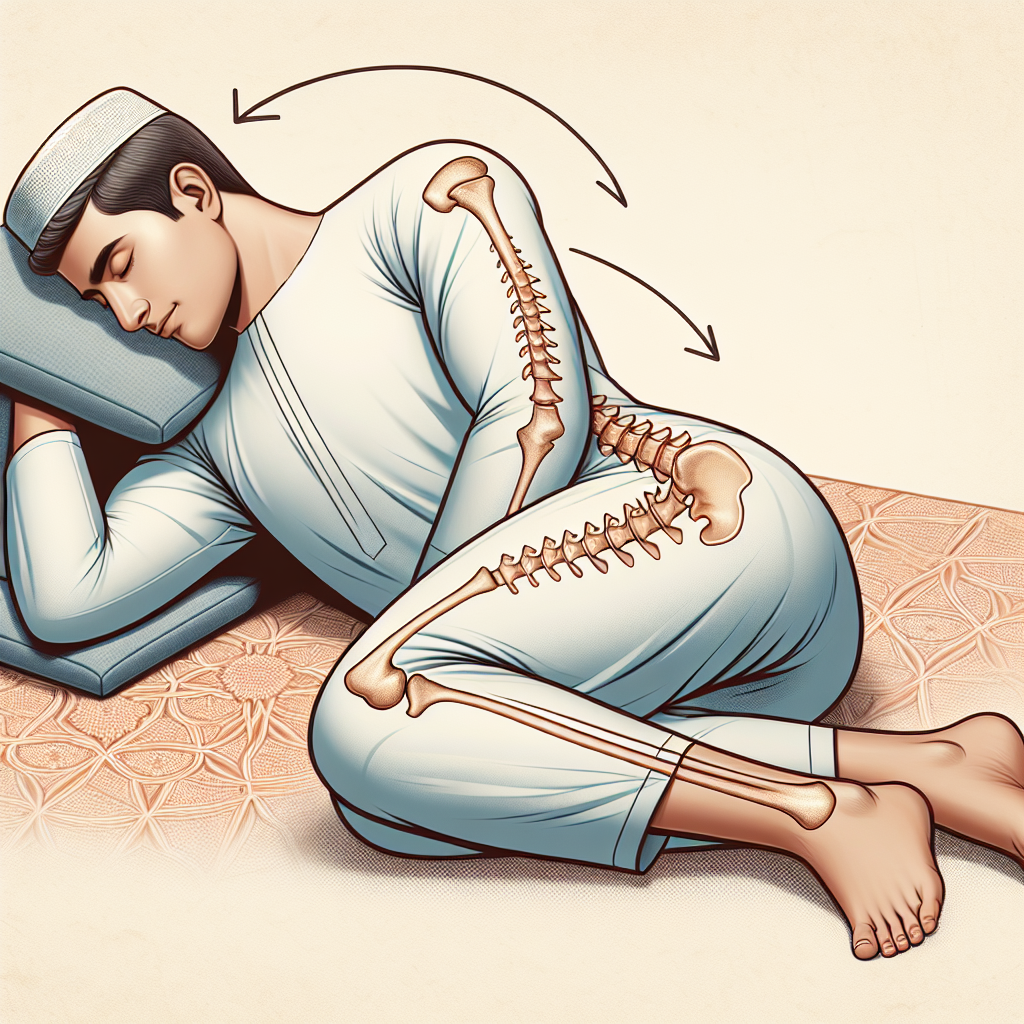
Have you ever wondered how your preferred sleeping position can impact your spinal alignment? In this article, we will explore the effects of side sleeping on your spine. We will delve into the potential benefits and drawbacks of this position and offer some tips to ensure optimal spinal alignment while sleeping on your side. So, if you’re curious about how side sleeping can affect your overall spine health, keep reading!

The Importance of Spinal Alignment
Spinal alignment refers to the proper positioning of the vertebrae in the spine, which helps to maintain a healthy and balanced posture. It is crucial for overall musculoskeletal health and plays a significant role in preventing a variety of spine-related issues.
What is spinal alignment?
Spinal alignment is the optimal positioning of the spine, where the natural curves of the neck, upper back, and lower back are maintained. When the spine is aligned correctly, the weight of the body is evenly distributed, reducing the risk of excessive pressure on certain areas. This alignment is necessary to ensure the proper functioning of nerves, muscles, and other structures in the spine.
Why is spinal alignment important?
Having proper spinal alignment is vital for various reasons:
- Pain prevention: Good spinal alignment helps in reducing the risk of back pain, neck pain, and other discomforts associated with poor posture.
- Proper nerve function: When the spine is aligned correctly, the nerves that run through the spinal column can function optimally, ensuring proper communication between the brain and the body.
- Improved mobility: Maintaining spinal alignment allows for better movement and flexibility, enabling you to perform daily activities with ease.
- Better breathing: Proper alignment of the spine can improve breathing by allowing the lungs to expand fully and reducing restrictions on the ribcage.
- Enhanced overall well-being: When your spine is aligned correctly, it positively impacts your overall well-being, promoting better sleep, reduced stress, and improved mood.

Side Sleeping and Spinal Alignment
Side sleeping is a common sleep position where an individual rests on their side with their legs and arms slightly bent. This sleep posture can significantly affect spinal alignment.
What is side sleeping?
Side sleeping is the preferred sleep position for many individuals. It involves lying on one’s side, either the left or the right, with the legs slightly bent and the arms relaxed. This sleep posture can offer numerous benefits, such as improved breathing and reduced snoring.
How does side sleeping affect spinal alignment?
While side sleeping can be comfortable for many, it is important to be aware of how it can influence spinal alignment. When sleeping on your side, it is essential to maintain a neutral spine position, where the natural curves of the spine are supported and aligned. Failure to do so can lead to various issues, including pain, tension, and muscular imbalances.

Benefits of Side Sleeping
Though side sleeping can pose challenges to spinal alignment, it also offers several noteworthy benefits.
Reduced snoring and sleep apnea
Side sleeping can help alleviate snoring and sleep apnea symptoms by keeping the airways open and reducing the likelihood of obstruction. This can lead to better quality sleep for both you and your partner.
Improved digestion
Sleeping on your left side, in particular, can aid in digestion by allowing gravity to help food move smoothly through the digestive system. This position may help reduce the occurrence of acid reflux and indigestion.
Reduced risk of acid reflux
Side sleeping, especially on the left side, can reduce the chances of acid reflux as it prevents stomach acid from flowing back into the esophagus. This can alleviate symptoms such as heartburn and regurgitation.
Challenges of Side Sleeping
Despite the benefits, side sleeping does come with some challenges that can affect spinal alignment and overall comfort.
Increased risk of shoulder and hip pain
Side sleeping can sometimes put pressure on the shoulder and hip of the side on which you sleep, leading to discomfort and potential pain. This can be exacerbated if the mattress and pillow are not adequately supportive.
Possible muscle imbalance
Repetitive side sleeping on one side can lead to muscle imbalances. The weight of the body pressing on one side for an extended period can cause certain muscles to become stronger or tighter, while others may weaken or lengthen.
Potential for wrinkles and skin aging
Sleeping on your side with your face pressed onto the pillow can contribute to the formation of wrinkles and skin aging over time. This occurs when the skin is constantly compressed and pushed in the same direction.
Proper Pillow Choice for Side Sleepers
Choosing the right pillow is crucial for maintaining proper spinal alignment while side sleeping.
Supporting the neck and head
Side sleepers should opt for pillows that provide adequate support to keep the neck and head aligned with the spine. Look for pillows with a higher loft, which fills the space between the shoulder and ear, ensuring proper alignment.
Aligning the spine
A good pillow for side sleepers should help align the spine by filling the gap between the neck and the mattress. Contour pillows or cervical pillows, which have a defined shape, can provide excellent support to maintain spinal alignment.
Choosing the right pillow material
The material of the pillow can also impact spinal alignment. Memory foam pillows are popular among side sleepers as they conform to the shape of the head and neck, offering customized support. Alternatively, latex pillows can provide a responsive and supportive surface.
Ideal Mattress for Side Sleepers
Choosing the right mattress is equally important for maintaining good spinal alignment while side sleeping.
Firmness and support
Side sleepers generally benefit from a mattress that is medium to medium-firm in order to provide ample support and prevent sinking too deeply into the mattress. The mattress should be able to conform to the body’s curves while maintaining overall alignment.
Contouring to the body
A mattress with good contouring properties can help relieve pressure points, such as the shoulders and hips, by distributing weight evenly. Look for materials like memory foam, which can conform to the body’s natural shape.
Motion isolation
If you sleep with a partner, consider a mattress with motion isolation capabilities. This feature helps minimize the transfer of movement, ensuring that any movement from your partner does not disrupt your sleep or compromise spinal alignment.
Exercises to Improve Spinal Alignment for Side Sleepers
Engaging in specific exercises can help improve spinal alignment and minimize the risks associated with side sleeping.
Stretches for the neck and shoulders
Performing gentle stretches to release tension in the neck and shoulder muscles can help maintain flexibility and reduce the likelihood of discomfort or pain.
Core strengthening exercises
A strong core can provide stability and support to the spine. Incorporating exercises that target the abdominal and back muscles can help improve overall spinal alignment.
Corrective posture exercises
Working on corrective postural exercises can help address imbalances caused by side sleeping, allowing the body to maintain a more neutral spine position.
Ergonomic Tips for Side Sleepers
In addition to the right pillow, mattress, and exercises, consider the following ergonomic tips to enhance spinal alignment while side sleeping.
Positioning of arms and legs
Try to keep your arms and legs in a relaxed position while side sleeping. Placing a pillow between your knees can help align the hips and reduce strain on the lower back.
Use of pillows and supports
Aside from the main pillow, additional pillows or supports can be used to maintain proper alignment. Placing a small pillow or rolled-up towel under the waist can provide additional lumbar support.
Maintaining a neutral spine
Ensure you maintain a neutral spine position while side sleeping. Avoid excessive twisting or bending of the spine and strive to keep the head aligned with the rest of the body.
Importance of Consulting a Healthcare Professional
While incorporating the above tips and practices can greatly benefit side sleepers, it is important to consult a healthcare professional for personalized advice.
Assessing individual needs
Everyone’s body is unique, and consulting a professional can help determine the specific needs of your spine and address any specific concerns or conditions you may have.
Addressing underlying conditions
If you have pre-existing back or neck conditions, it is essential to consult with a healthcare professional to ensure that your side sleeping position does not aggravate or worsen these conditions.
Receiving personalized advice
A healthcare professional can provide personalized recommendations on pillow choice, mattress selection, and exercises that specifically cater to your spinal alignment needs as a side sleeper.
Conclusion
Maintaining proper spinal alignment is crucial for overall musculoskeletal health, and side sleeping can either promote or hinder this alignment. By understanding the impact of side sleeping on spinal alignment and implementing the right pillows, mattresses, exercises, and ergonomic tips, you can enjoy the benefits of side sleeping while minimizing the potential challenges. Remember, consulting a healthcare professional will provide you with tailored guidance to ensure you achieve and maintain optimal spinal alignment throughout your sleep.





